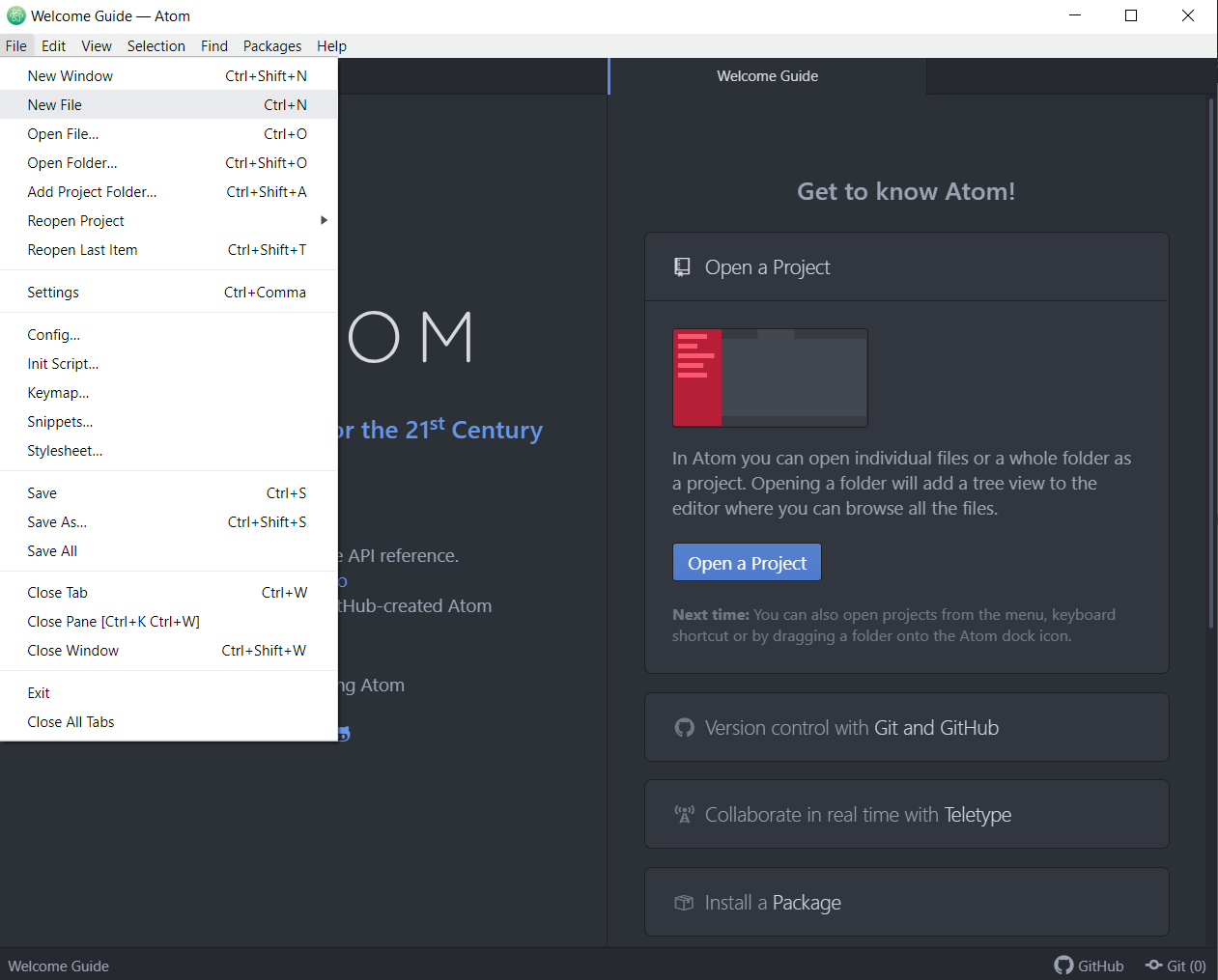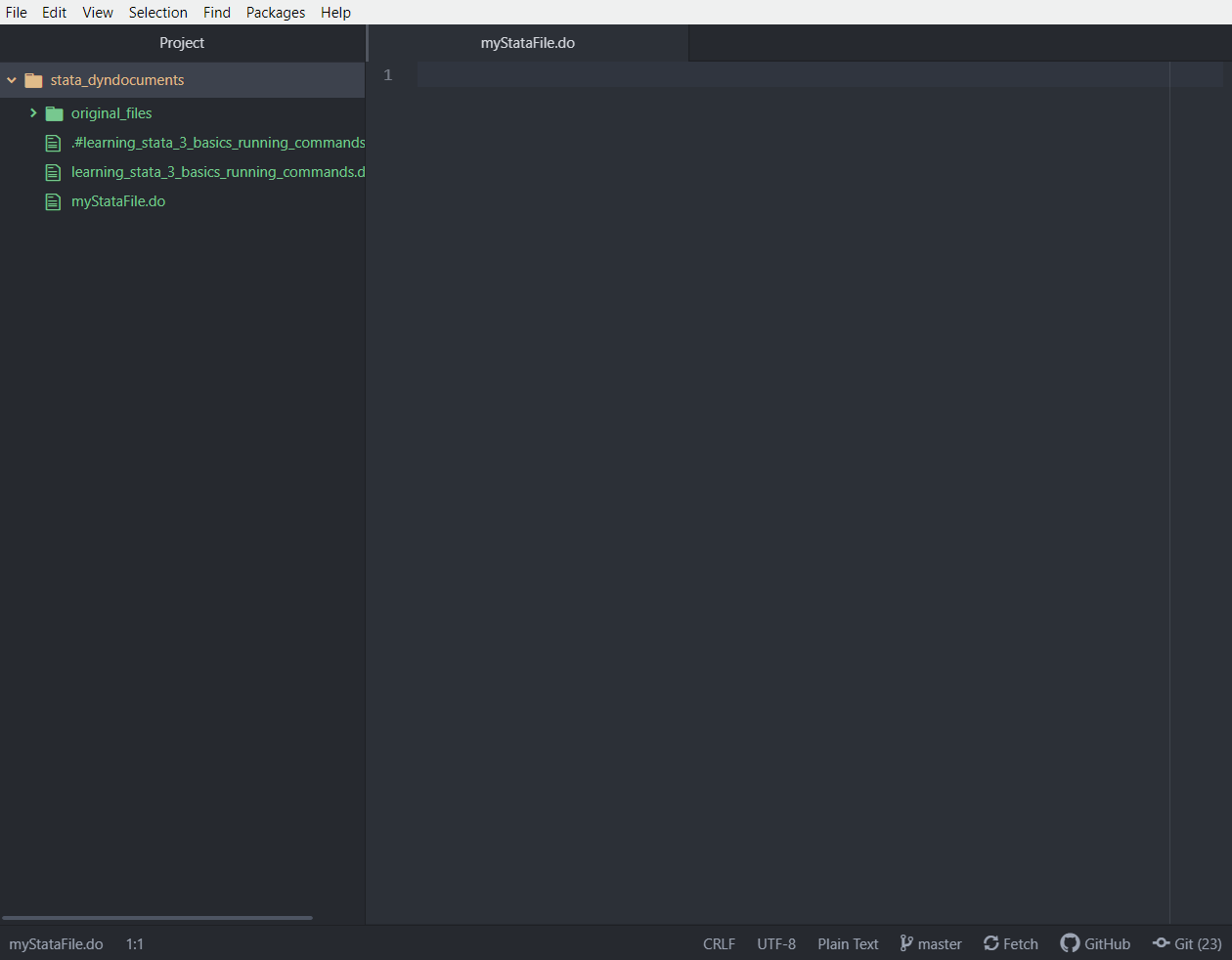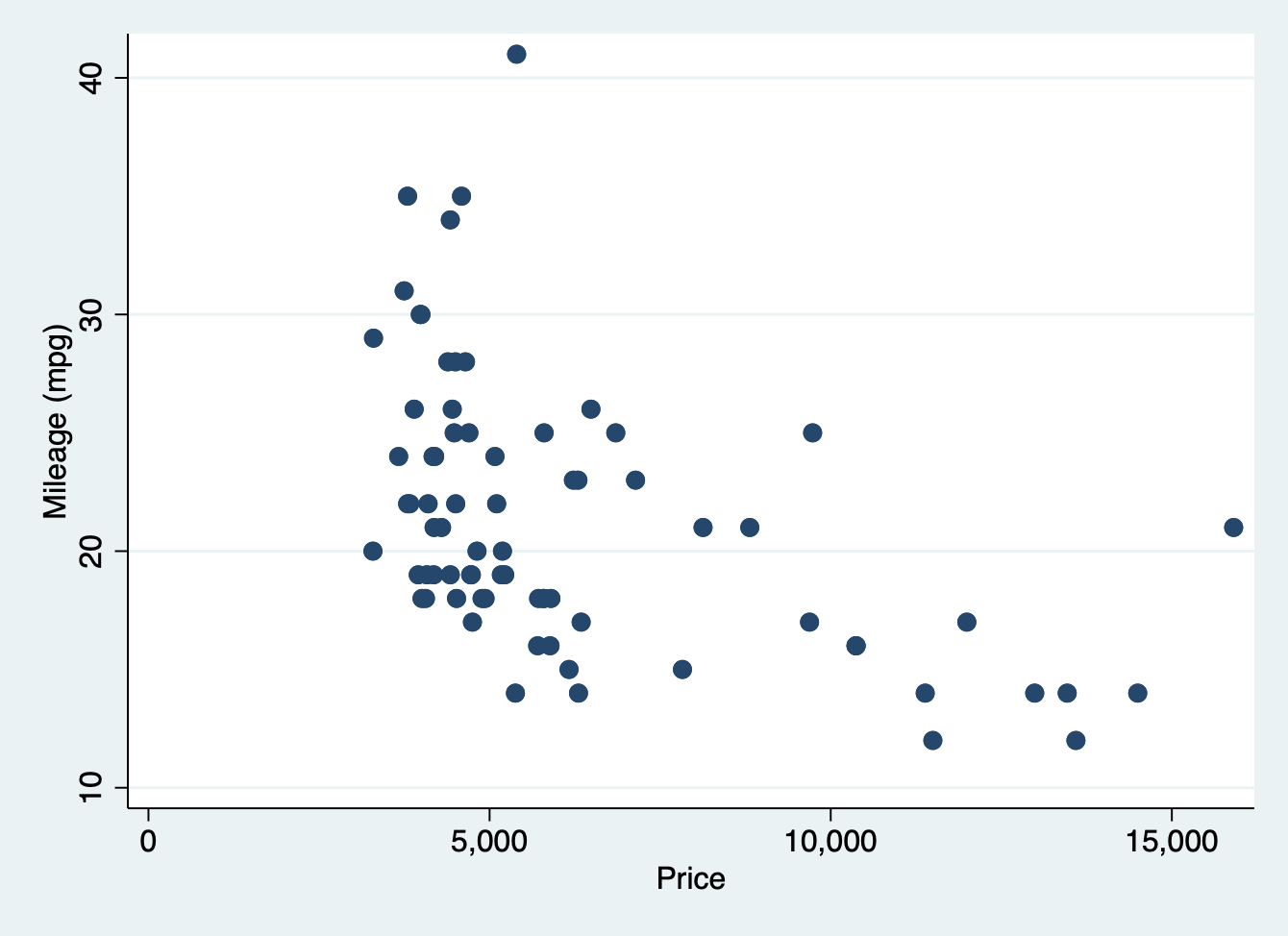Basics: Running Commands
Using your workspace
If you are planning on using Atom, open the program and create a new file with
the extension .do (e.g. myStataFile.do). You will likely need to explicitly
save the file with a name before you can begin working on it.


Alternatively, if you are not using Atom, open up the Stata window. You can run
commands within the Stata console without creating a .do file, but you will
want to create one when running your own analyses; if you do not, you will find
it immensely difficult to reproduce your findings (in short, always make a .do
file).

What’s a .do file?
.do files are simply any file which has a ‘.do’ file extension. .do files
contain instructions (or “commands”) for Stata to execute. The commands in a do
file are inert. Typing commands in a .do file does nothing, until you
highlight them and run (or “do”) them. At that point, they are submitted to the
“command” prompt in Stata, and they are executed in the order that they are
submitted. In the next lesson, we will discuss creating well-organized and
readable .do files in more depth.
Running Stata commands
First, type the following into your .do file:
sysuse auto.dta
The text above is a command. It tells Stata to open data set that is stored
internally within the program. Sysuse is the command, and auto.dta is the
name of the data set. Stata data sets are saved with a .dta extension.
When you are finished with a command, you must include a carriage return (by hitting “enter”), which ends the line and tells Stata the the command is complete. Note that empty lines can be included; these are helpful for making your code more easy to read.
If you are using Atom, you should be able to run this command by placing your cursor on the line with the command and hitting either “ctrl” + “enter” or “shift” + “enter” (there are many different ways to execute commands in Atom. For a list, hit “ctrl” + “uparrow” + “P” or “cmd” + “uparrow” + “P”). The results should be displayed below the code. If you are using the Stata window, just “select all” (“ctrl” + “A” in Windows, or “cmd” + “A” in Mac O/S) and then click the “do” icon in the top right corner. The results will appear in the “Results” window in Stata.
Stata comments (or, prose within your instructions)
/* Here is my comment. */
If you run a .do file containing the code above, nothing will happen. This is
because I opened the .do file with a “/” followed by a “*” (no space). This
character combination tells Stata that the text that follows is not a command.
To help the reader distinguish between non-exectuable text and commands, your
text editor will make the non-executable text a different color than those which
are not demarcated as comments. Within the .do file editor (regardless of
whether your are using Atom or Stata’s GUI), you will see that commands in a .do
file are presented in different colors. Your comments can span multiple lines; to end them, write “*/”. The next line Stata reads will be interpreted as a command.
Creating notes
What is this “auto” data set? Let’s find out.
. notes
_dta:
1. From Consumer Reports with permission
This command displays any notes about the data set that have been stored. If we look at the “Results” window in Stata, we will see that Stata returned some information regarding where the data come from. Let’s add a note to remind ourselves that the data was collected in 1978.
. note: The data are based on automobiles that were produced in 1978.
.
. notes
_dta:
1. From Consumer Reports with permission
2. The data are based on automobiles that were produced in 1978.
Notice how the new note has been added to our data set. This is useful to keep track of specific things that are important to document about your data. Keep in mind we would have to save our data set for new to be stored permanently. We will discuss that later.
An overview of exploring your data
Let’s learn some more about our data set.
. codebook
------------------------------------------------------------------------------------------------------------------------------------------------
make Make and model
------------------------------------------------------------------------------------------------------------------------------------------------
Type: String (str18), but longest is str17
Unique values: 74 Missing "": 0/74
Examples: "Cad. Deville"
"Dodge Magnum"
"Merc. XR-7"
"Pont. Catalina"
Warning: Variable has embedded blanks.
------------------------------------------------------------------------------------------------------------------------------------------------
price Price
------------------------------------------------------------------------------------------------------------------------------------------------
Type: Numeric (int)
Range: [3291,15906] Units: 1
Unique values: 74 Missing .: 0/74
Mean: 6165.26
Std. dev.: 2949.5
Percentiles: 10% 25% 50% 75% 90%
3895 4195 5006.5 6342 11385
------------------------------------------------------------------------------------------------------------------------------------------------
mpg Mileage (mpg)
------------------------------------------------------------------------------------------------------------------------------------------------
Type: Numeric (int)
Range: [12,41] Units: 1
Unique values: 21 Missing .: 0/74
Mean: 21.2973
Std. dev.: 5.7855
Percentiles: 10% 25% 50% 75% 90%
14 18 20 25 29
------------------------------------------------------------------------------------------------------------------------------------------------
rep78 Repair record 1978
------------------------------------------------------------------------------------------------------------------------------------------------
Type: Numeric (int)
Range: [1,5] Units: 1
Unique values: 5 Missing .: 5/74
Tabulation: Freq. Value
2 1
8 2
30 3
18 4
11 5
5 .
------------------------------------------------------------------------------------------------------------------------------------------------
headroom Headroom (in.)
------------------------------------------------------------------------------------------------------------------------------------------------
Type: Numeric (float)
Range: [1.5,5] Units: .1
Unique values: 8 Missing .: 0/74
Tabulation: Freq. Value
4 1.5
13 2
14 2.5
13 3
15 3.5
10 4
4 4.5
1 5
------------------------------------------------------------------------------------------------------------------------------------------------
trunk Trunk space (cu. ft.)
------------------------------------------------------------------------------------------------------------------------------------------------
Type: Numeric (int)
Range: [5,23] Units: 1
Unique values: 18 Missing .: 0/74
Mean: 13.7568
Std. dev.: 4.2774
Percentiles: 10% 25% 50% 75% 90%
8 10 14 17 20
------------------------------------------------------------------------------------------------------------------------------------------------
weight Weight (lbs.)
------------------------------------------------------------------------------------------------------------------------------------------------
Type: Numeric (int)
Range: [1760,4840] Units: 10
Unique values: 64 Missing .: 0/74
Mean: 3019.46
Std. dev.: 777.194
Percentiles: 10% 25% 50% 75% 90%
2020 2240 3190 3600 4060
------------------------------------------------------------------------------------------------------------------------------------------------
length Length (in.)
------------------------------------------------------------------------------------------------------------------------------------------------
Type: Numeric (int)
Range: [142,233] Units: 1
Unique values: 47 Missing .: 0/74
Mean: 187.932
Std. dev.: 22.2663
Percentiles: 10% 25% 50% 75% 90%
157 170 192.5 204 218
------------------------------------------------------------------------------------------------------------------------------------------------
turn Turn circle (ft.)
------------------------------------------------------------------------------------------------------------------------------------------------
Type: Numeric (int)
Range: [31,51] Units: 1
Unique values: 18 Missing .: 0/74
Mean: 39.6486
Std. dev.: 4.39935
Percentiles: 10% 25% 50% 75% 90%
34 36 40 43 45
------------------------------------------------------------------------------------------------------------------------------------------------
displacement Displacement (cu. in.)
------------------------------------------------------------------------------------------------------------------------------------------------
Type: Numeric (int)
Range: [79,425] Units: 1
Unique values: 31 Missing .: 0/74
Mean: 197.297
Std. dev.: 91.8372
Percentiles: 10% 25% 50% 75% 90%
97 119 196 250 350
------------------------------------------------------------------------------------------------------------------------------------------------
gear_ratio Gear ratio
------------------------------------------------------------------------------------------------------------------------------------------------
Type: Numeric (float)
Range: [2.19,3.89] Units: .01
Unique values: 36 Missing .: 0/74
Mean: 3.01486
Std. dev.: .456287
Percentiles: 10% 25% 50% 75% 90%
2.43 2.73 2.955 3.37 3.72
------------------------------------------------------------------------------------------------------------------------------------------------
foreign Car origin
------------------------------------------------------------------------------------------------------------------------------------------------
Type: Numeric (byte)
Label: origin
Range: [0,1] Units: 1
Unique values: 2 Missing .: 0/74
Tabulation: Freq. Numeric Label
52 0 Domestic
22 1 Foreign
If we scroll through the “Results” window, we will see that this command returned detailed information about all of the variables in this data set. We can also get a more minimalist version of the codebook.
. codebook, compact
Variable Obs Unique Mean Min Max Label
------------------------------------------------------------------------------------------------------------------------------------------------
make 74 74 . . . Make and model
price 74 74 6165.257 3291 15906 Price
mpg 74 21 21.2973 12 41 Mileage (mpg)
rep78 69 5 3.405797 1 5 Repair record 1978
headroom 74 8 2.993243 1.5 5 Headroom (in.)
trunk 74 18 13.75676 5 23 Trunk space (cu. ft.)
weight 74 64 3019.459 1760 4840 Weight (lbs.)
length 74 47 187.9324 142 233 Length (in.)
turn 74 18 39.64865 31 51 Turn circle (ft.)
displacement 74 31 197.2973 79 425 Displacement (cu. in.)
gear_ratio 74 36 3.014865 2.19 3.89 Gear ratio
foreign 74 2 .2972973 0 1 Car origin
------------------------------------------------------------------------------------------------------------------------------------------------
This is much easier to process, in my humble opinion! Notice that I inserted a comma before adding ‘compact.’ In Stata syntax, a comma denotes options that can be enacted within specific commands. We can also specify a subset of variables using the codebook.
. codebook mpg price trunk foreign, compact
Variable Obs Unique Mean Min Max Label
------------------------------------------------------------------------------------------------------------------------------------------------
mpg 74 21 21.2973 12 41 Mileage (mpg)
price 74 74 6165.257 3291 15906 Price
trunk 74 18 13.75676 5 23 Trunk space (cu. ft.)
foreign 74 2 .2972973 0 1 Car origin
------------------------------------------------------------------------------------------------------------------------------------------------
.
. describe
Contains data from /Applications/Stata/ado/base/a/auto.dta
Observations: 74 1978 automobile data
Variables: 12 13 Apr 2020 17:45
(_dta has notes)
------------------------------------------------------------------------------------------------------------------------------------------------
Variable Storage Display Value
name type format label Variable label
------------------------------------------------------------------------------------------------------------------------------------------------
make str18 %-18s Make and model
price int %8.0gc Price
mpg int %8.0g Mileage (mpg)
rep78 int %8.0g Repair record 1978
headroom float %6.1f Headroom (in.)
trunk int %8.0g Trunk space (cu. ft.)
weight int %8.0gc Weight (lbs.)
length int %8.0g Length (in.)
turn int %8.0g Turn circle (ft.)
displacement int %8.0g Displacement (cu. in.)
gear_ratio float %6.2f Gear ratio
foreign byte %8.0g origin Car origin
------------------------------------------------------------------------------------------------------------------------------------------------
Sorted by: foreign
Note: Dataset has changed since last saved.
What is the average mpg and price for cars in our data set?
. summarize mpg price // summary statistics for the 'mpg' variable
Variable | Obs Mean Std. dev. Min Max
-------------+---------------------------------------------------------
mpg | 74 21.2973 5.785503 12 41
price | 74 6165.257 2949.496 3291 15906
Getting help
Do you want to know more about the ‘summarize’ command? There’s a command for that:
. help summarize // Notice - a separate help window opens.
Brief comments
In Stata, you can leave comments in three ways. In the command above, we used double backslashes after entering a command. Thus, a command and a note can exist on the same line. But the command must always precede the comment. It is important to note that, when using “//” for comments, it is turned off when you enter a carriage return and start a new line.
. * Also - you can begin a line with one or more asterisk to start a note.
. ** See! This is a note too!
. *** So is this! Note how I used a tab to start the line -- that's OK. ***
. * But asterisks can only trigger comments when they BEGIN a line (unlike the "//").
. * More on that later.
A quick graph
Let’s finish up by making a graph.
scatter mpg price

If you are using the Stata GUI, notice that the graph does not appear in the “Results” window. Instead, there is a separate window where graphs appear, and can be edited. More on that later.
Wrapping up
Finally – we are done with our analyses. When we close Stata, our output in the
“Results” window will not be saved, and our graph will disappear. That’s OK –
we can just open our .do file and re-run it. We should get the same exact
output.
To quit Stata, run:
exit